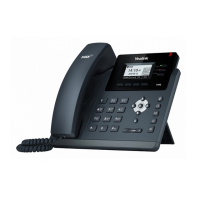Administrator’s Guide for SIP-T2 Series/T4 Series/T5 Series IP Phones
190
It configures the unique identifier used by the soft key or DSS key configuration to
reference the enhanced DSS keys entry for macro X.
It cannot start with a digit. This parameter must have a value, it cannot be left blank.
Example:
edk.edklist.2.mname = macro2
Note: If there are two or more same macros, the soft key or DSS key will invoke the
macro with a smallest value of X. It works only if “features.enhanced_dss_keys.enable”
is set to 1 (Enabled).
It configures the action string that contains a macro definition of the action that the
softkey or DSS key performs.
This parameter must have a value, it cannot be left blank.
Example:
edk.edklist.2.action = 1013$Tinvite$
Note: It works only if “features.enhanced_dss_keys.enable” is set to 1 (Enabled).
[1]
X is the macro ID. X=1-255.
EDK Prompt Configuration
The Enhanced DSS Keys (EDK) Prompt parameters must be used if interactivity with user is implemented
as part of any macro.
The following table lists the parameters you can use to configure EDK prompt.
edk.edkprompt.X.enable
[1]
It enables or disables Enhanced DSS Keys (EDK) prompt X.
Note: If a macro attempts to use an EDK prompt that is disabled, the macro execution
fails. It works only if “features.enhanced_dss_keys.enable” is set to 1 (Enabled).

